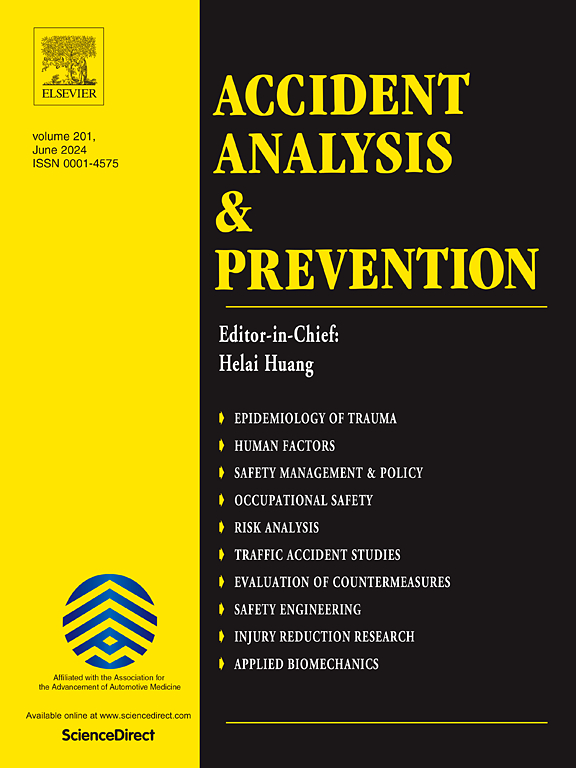Exploring the relationship between cyclists’ perceived unsafety, crash risk, and exposure in Dutch cities
IF 6.2
1区 工程技术
Q1 ERGONOMICS
引用次数: 0
Abstract
Road safety of cyclists can be investigated in terms of objective measures based on crashes and conflicts and in subjective measures based on perceptions of cyclists. The number of studies investigating these two safety measures simultaneously is limited, in particular studies that also include exposure metrics. Therefore, the present study aims to find out to what extent perceived unsafety and crash risk of cyclists correlate and spatially align and how this relates to exposure to cyclists and motorised vehicles in the four largest Dutch cities. For this purpose, data and models estimated in earlier work on objective road safety and perceived safety of cyclists are combined. Perceived unsafety is expressed as the probability that a cyclist indicates a road section as unsafe while crash risk is expressed as the probability of a bicycle crash occurring. Results show a significant positive correlation between perceived unsafety and crash risk. It is also shown that perceived unsafety increases stronger than crash risk, which is particularly related to an increase in exposure to cyclists, followed by exposure to motorised vehicles. Conversely, crash risk remains relatively low with an increase in exposure to cyclists, which might indicate a safety-in-numbers effect. However, from a certain point in the exposure to cyclists, crash risk increases more strongly. Presumably, this hints at a situation beyond the safety-in-numbers effect where increasing cycling volumes affect cycling safety more negatively. It can be concluded that the probability of perceiving a road section as unsafe significantly follows the same direction as the probability of a bicycle crash occurring, but with a increasing exposure to cyclists perceived unsafety increases stronger than crash risk. With higher exposure to motorised vehicles, on the other hand, the increase in perceived unsafety and crash risk is more gradual.
探索荷兰城市中骑自行车者感知不安全、碰撞风险和暴露之间的关系
骑自行车者的道路安全可以通过基于碰撞和冲突的客观测量和基于骑自行车者感知的主观测量来调查。同时调查这两种安全措施的研究数量有限,特别是还包括暴露度量的研究。因此,本研究的目的是找出骑车者的不安全和撞车风险在多大程度上相互关联,在空间上是一致的,以及这与荷兰四个最大城市中骑车者和机动车的暴露有何关系。为此,将早期关于客观道路安全和骑自行车者感知安全的工作中估计的数据和模型结合起来。感知不安全被表示为骑自行车的人指出某个路段不安全的概率,而碰撞风险被表示为发生自行车碰撞的概率。结果显示,感知不安全与碰撞风险之间存在显著正相关。研究还表明,人们对不安全的感知比碰撞风险的增加更强烈,这与骑自行车的人的接触增加有关,其次是机动车的接触。相反,随着骑车者接触的增加,撞车风险仍然相对较低,这可能表明了数量安全效应。然而,从一定程度上暴露于骑自行车的人,撞车风险增加更强烈。据推测,这暗示了一种超出数量安全效应的情况,即骑行量的增加对骑行安全的影响更大。可以得出结论,感知路段不安全的概率与发生自行车碰撞的概率显著遵循相同的方向,但随着骑自行车者接触的增加,感知不安全的增加强于碰撞风险。另一方面,与机动车辆接触越多,感知到的不安全和碰撞风险的增加就越缓慢。
本文章由计算机程序翻译,如有差异,请以英文原文为准。
求助全文
约1分钟内获得全文
求助全文
来源期刊

Accident; analysis and prevention
Multiple-
CiteScore
11.90
自引率
16.90%
发文量
264
审稿时长
48 days
期刊介绍:
Accident Analysis & Prevention provides wide coverage of the general areas relating to accidental injury and damage, including the pre-injury and immediate post-injury phases. Published papers deal with medical, legal, economic, educational, behavioral, theoretical or empirical aspects of transportation accidents, as well as with accidents at other sites. Selected topics within the scope of the Journal may include: studies of human, environmental and vehicular factors influencing the occurrence, type and severity of accidents and injury; the design, implementation and evaluation of countermeasures; biomechanics of impact and human tolerance limits to injury; modelling and statistical analysis of accident data; policy, planning and decision-making in safety.
 求助内容:
求助内容: 应助结果提醒方式:
应助结果提醒方式:


